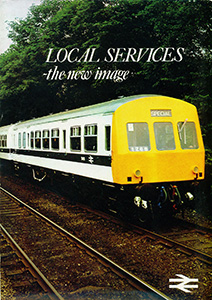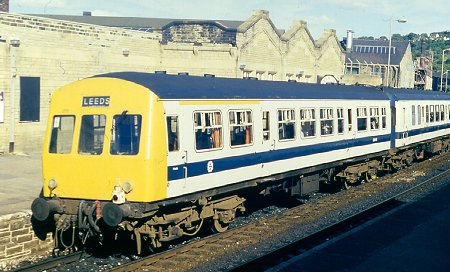Class 101 Met-Camm 2,3 & 4-car DMUs
Refurbishment
The Protoype
While DMUs made a considerable improvement over the stock that they replaced, after a period more modern rolling stock showed that DMU interiors were somewhat functional. The DMUs were still technically sound and had a good life expectancy (see the 1974 NTP details) so BR embarked on a scheme of refurbishing 1,800 vehicles to provide more attractive travelling conditions.
One set was experimented on for this, a three-car Hamilton Met-Camm set, after which the set made a three month tour of the country during which Passenger Transport Executives and other bodies with interests in local transport could inspect and comment on the design.
Modifications
The trial refurbishment of vehicles 51451, 59545 and 51518 took place at Doncaster Works, starting in April 1974 and involved a number of significant modifications to the interior of vehicles such as the fitting of fluorescent lighting, new upholstery and carpeting, and fitting of extra heating equipment. There were different degrees of interior restyling.
It was a version of the low-cost scheme, as applied to 59545 & 51451, that was adopted, where seats were re-trimmed (brown moquette) and panelling and flooring replaced as appropriate (the DMBS had it's wall panels just cleaned and the trailer had vinyl added), and fluorescent lighting replacing tungsten. The trademark of the DMU refurbishment plan was the use of orange laminate in vehicle vestibules, was not applied to this pair.
(Eddie Knorn notes: "I show that 59545 in prototype set DID have orange vestibules. 51451 did not, but did have a brown vinyl behind luggage racks.")
The third vehicle, 51518, received virtually a complete interior restyling. A double row of fluorescent tubes gave six times the light previously provided, and together with lowered ceiling panels in the style of Mk 2 hauled stock created an impression of greater interior width. New wall paneling and Class 313 style seats with green/brown seat coverings in the second class section provided an attractive colour scheme, orange plastic vestibules, whilst an innovation in the first class was the provision of adjustable Mk2f/Mk3 Inter-City 70 seats. Other major changes in this vehicle included the provision of the latest hot water system and fittings in the revamped toilet. New designs of engine mountings and an improved silencer system provided a quieter and smoother ride. Alterations were also made to the heating system to ensure that it was more responsive to temperature changes.
Externally three major modifications were evident, these being the replacement of rain guttering over bodyside doors with one long cantrail gutter on each side running the length of the vehicle, the fitting of a saloon heating air intake to the bodyside below the small window on the second man's side, to end the problem of stationery vehicles drawing in fumes while standing at platforms, and finally the removal of the redundant two character train describers and headcodes where formerly fitted. The four lamp fronted vehicles had the top and centre lamps removed.
Promotion
The vehicles emerged from Doncaster Works on the 24th June and toured extensively from July to September, and barely a local newspaper or magazine of the period failed to publish the mass produced regulation BR publicity action and interior shots.



Three views of the set soon after conversion, at Bletchley K.J.C. Jackson / Ian McDonald Collection.

In August 1974 the set toured the ER. In September it tackled these LMR and SR dates: 2nd-4th Marylebone, 5th-6th Birmingham Moor Street, 9th-10th Derby, 11th-12th Chester, 13th Liverpool Lime Street, 16th-17th Manchester Piccadilly, 18th Preston, 19th Carlisle, 23rd-24th (unknown).
A promotional brochure was produced to show the changes to the vehicles.
They set was in a new livery of white body and Rail Blue waist band (after experiments on Class 100s), with local Metropolitan county symbols introduced on this background. The blue stripe differed in thickness on either side (see livery section).
The vehicles afterwards went back to normal duties. When the first class was downgraded to second the Inter-City seats was replaced by ordinary second class 2+3 and 2+2 seating, and the carpets and curtains were removed. The lowered ceiling panels remained.
Scotland
In April 1975 the set was transfered from the ER to Eastfield where it was scheduled to work the 10:35 Glasgow Queen Street - Oban and return from May 26th till October 4th. By now it had gained the nickname "White Ghost".

Easily identified by their narrower than normal blue stripe, the prototype refurbished Class 101 cars 51518, 59545 and 51451 are seen about to enter Inverkeithing from the Edinburgh direction in August 1976. The branch on the left went to Rosyth Dockyard, which had a service for employees Alan Rintoul.
In these early days the asbestos was not removed from the vehicles, so they were destined for early withdrawal. Centre car 59545 was first to go in September ‘87. The set had been split up many years before when it returned to the ScR, but the two power cars were reunited (running with 59557) as set no. 101 326 for their last few months before withdrawal. Their last noted working was on the 1st October, operating an Edinburgh to Stirling return service before being put in store at Thornton Yard. They headed south via Millerhill on the 25th November with other redundant stock. They were not cannabilised in any way before going into the Mayer Newman firing tunnel at Snailwell on the 30th November 1987.
Other Vehicles
In all, 562 (of the 590 built) Class 101 vehicles would be refurbished.
The process began in early 1976 with the work being done at Doncaster (278 vehicles), Derby (100), Glasgow (131) and Swindon (53) Works, and was completed in April 1984.
This view of 56401 (with 50224 at Keighley on the 4th August 1979) shows the standardized version of the refurbished livery. Robert Frise.
Within a few years it was realised that the white livery was not practical and vehicles going through the refurbishment process were turned out in blue and grey livery.
The white/blue stripe livery had been applied to 264 Class 101 vehicles, Glasgow Works was the first to switch to blue/grey at the end of 1978, the other works would make the change in June 1979.
Vehicle Details
The table below shows the Works date and the livery applied for each vehicle. Information supplied by Eddie Knorn, extracted from the BR vehicle record cards.

Summary
Orders
Batches
Description - Technical
Description - Interior
Description - Variations
Description - Modifications
Met-Camm Adverts
Diagrams
Drivers Instructions
Refurbishment
Numbering
Liveries
Operations - Initial
Operations - Later
Operations - Scottish Region
Accidents
Daisy - 101685
Observation Saloon 6300
Parcel Use
Departmental Use
Images
Details about preserved Class 101s can be found here.
Many thanks to Mac Winfield and Eddie Knorn for their assistance in the preparation of this section.




